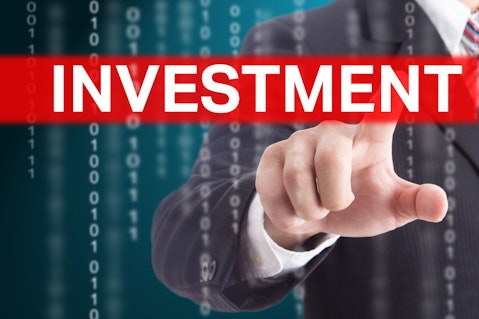Blackstone Inc. (NYSE:BX) Q2 2023 Earnings Call Transcript July 20, 2023
Blackstone Inc. beats earnings expectations. Reported EPS is $0.93, expectations were $0.92.
Operator: Good day and welcome to the Blackstone Second Quarter 2023 Investor Call. Today’s conference is being recorded. At this time, all participants are in a listen-only mode. [Operator Instructions] At this time, I’d like to turn the conference over to Weston Tucker, Head of Shareholder Relations. Please go ahead.
Weston Tucker: Thank you, Katie, and good morning, and welcome to Blackstone’s second quarter conference call. Joining today are Steve Schwarzman, Chairman and CEO; Jon Gray, President and Chief Operating Officer; and Michael Chae, Chief Financial Officer. Earlier this morning, we issued a press release and slide presentation, which are available on our website, and we expect to file our 10-Q report in a few weeks. I’d like to remind you that today’s call may include forward-looking statements, which are uncertain and outside of the firm’s control and may differ from actual results materially. We do not undertake any duty to update these statements. For a discussion of some of the risks that could affect results, please see the Risk Factors section of our 10-K.
We’ll also refer to non-GAAP measures, and you’ll find reconciliations in the press release on the shareholders page of our website. Also note that nothing on this call constitutes an offer to sell or a solicitation of an offer to purchase an interest in any Blackstone fund. This audiocast is copyrighted material of Blackstone and may not be duplicated without our consent. So on results, we reported GAAP net income for the quarter of $1.2 billion. Distributable earnings were also $1.2 billion or $0.93 per common share, and we declared a dividend of $0.79 per share, which will be paid to holders of record as of July 31. With that, I’ll now turn the call over to Steve.
Steve Schwarzman: Thank you, Weston, and good morning. Thank you all for joining the call. Blackstone reached a remarkable milestone in the second quarter. We surpassed $1 trillion of assets under management. The first alternative manager to do so of more than three years ahead of the aspirational roadmap we presented at our Investor Day in 2018. This achievement is significant in many ways, including for me personally. I founded Blackstone with my partner, Pete Peterson, in 1985 with $400,000 of startup capital. We sent out 450 personal announcements of our new venture and published a full-page newspaper ad with the expectation that the phone would start ringing off the hook. It was a humbling experience when no one called other than a few people wishing us luck.
When we started raising our first private equity fund in 1986 with a $1 billion target, we discovered that giving a $5 million or $10 million commitment was a substantial accomplishment. Fortunately, we hung in there, and we were ultimately successful. Looking at Blackstone today, I feel an immense sense of pride. We’ve established an unparalleled global platform of leading business lines, offering over 70 distinct investment strategies. We believe our clients view us as the gold standard in alternative asset management. And this milestone reflects the extraordinary level of trust we’ve built with them over nearly four decades. We’ve delivered for them in good times and bad, generating $300 billion of aggregate gains with minimal losses. In fact, virtually all of our drawdown funds we’ve launched in our history, have been profitable for our investors.
Our performance has helped secure retirees’ pensions, fund students educations, pay health care benefits and protect and grow the savings of individual investors. We are tremendously proud of the role we’ve played in driving these outcomes. Our ability to create excess returns over long periods of time in support of these critically important objectives is what distinguishes us as a firm that powers our growth. This milestone is also reflective of Blackstone’s distinctive positioning as the leading innovator in our industry. At our founding, we determined that building a great company required us to be in a continuous innovation mode, which we have institutionalized as a core competency of the firm. Our original strategic plan, which was to start in corporate advisory and then quickly move into private equity, followed by a succession of other asset management businesses over time.
We only entered a new area, and we saw the opportunity to generate great risk-adjusted returns for our customers. We identified a remarkable leader and the new area created intellectual capital that benefited the rest of the firm. For example, we entered the hedge fund to funds business in 1990. Real estate in 1991 when values had collapsed following the savings and loan crisis. And credit in 1998, which we expanded substantially in 2008 ahead of the generational investment opportunities that arose from the global financial crisis. In 2011, we launched a dedicated private wealth business. The following year, we created tactical opportunities. And the year after that, we entered the nascent secondaries market for drawdown funds. In 2017, we launched our infrastructure strategy.
In 2018, we started both our insurance solutions management and life sciences businesses. And in 2020, we launched our first growth equity fund. Today, nearly all of these major lines of business are market leaders in their respective asset classes with exceptional long-term performance. There are many advantages that come from our unique scale. With our portfolio of over 230 companies, 12,000 real estate assets and one of the largest lending businesses in the world, we believe that we have more information than just about anyone competing with us. We specialize in the production and analysis of enormous amounts of data, which we review every week in our Monday morning meetings with each of our major product lines. This process done over 35 years, helps us identify trends before others and adjust where we invest our clients’ capital.
This also allows us to maintain a hands-on management style, keeps our professionals fully connected and supports centralized decision-making. Our focus on data aggregation and analysis also led us to establish our own data science group early as 2015. We started building a team of exceptional data scientists, which today numbers over 50 people, and we are rapidly and significantly expanding our capabilities in artificial intelligence. We’ve been using AI to help improve operations and our portfolio companies as well as with Blackstone itself. We believe that the new generation of AI has the potential to transform companies and industries. And the timeliness and effectiveness of its implementation will be determinative of who the winners and losers will be.
Blackstone fortunately, is in an enviable position in the alternative asset world with an 8-year head start in this field, and we are committed to further expanding our leadership position there as quickly as possible. Our growth along with our commitment to meritocracy have also allowed us to attract and retain great talent, many of the best people in the world want to work here at Blackstone. This year, we had 62,000 unique applicants for 169 1st year analyst positions, equating to a selection rate of less than 0.3 of 1%. Getting an entry-level job at Blackstone is 12x harder than getting into Harvard. I doubt I’d be able to be hired today. I’m not sure that’s a great thing. Our scale has also made the firm even safer. We’re an A+ rated manager of third-party capital distributed across hundreds of segregated investment vehicles.
We don’t depend on deposits for our funding. And the vast majority of our capital is under long-term contracts or perpetual, which we carefully aligned with the duration of our investments. We don’t operate with a cross-collateralized balance sheet like depository institutions. We have virtually no net leverage at the parent company compared to U.S. banks with an average of 12x leverage, and we have no insurance liabilities. We’ve always believed in extreme conservatism in managing our capital structure and the structure of our funds. As the largest manager today, Blackstone has led the adoption of alternatives which have revolutionized the field of investment management. When we started in 1985, alternatives were basically limited to private equity, and there were only a few public pension funds and insurance companies who invested in the asset class.
Endowments, sovereign wealth funds and retail investors, for example, have virtually no participation. Over the subsequent four decades, alternatives have grown to $12 trillion of assets. But this is still small compared to the $225 trillion of liquid stocks and bonds. With a minimal share of total investable assets today, we expect alternatives to expand substantially in the future. I believe that Blackstone, given our unique brand and global reach is the best-positioned firm in the world to capture future opportunities for growth in the alternatives area. The most compelling of these today include private credit and insurance, infrastructure globally, energy transition, large sciences the development of the alternatives business in Asia and the private wealth channel, where the democratization of alternatives in its early stages.
Jon will discuss these areas in more detail. Our mission since 1985 is to be the best in the world at what we choose to do. Even this we’ve grown, we’ve never strayed from this mission or from the core values that have defined us, including excellence, integrity, aristocracy, teamwork and dedication to serving our customers. Work at our firm, you must believe in our mission and embody these values. Blackstone is an extraordinary place. Our prospects are accelerating. We never rest on our achievements, and we’re always looking ahead, striving to lift the firm to new heights. I strongly believe the best is ahead for Blackstone, investors in our funds and our shareholders. And with that, turn the ball over to Jon.

Copyright: hin255 / 123RF Stock Photo
Jon Gray: Thank you, Steve, and good morning, everyone. $1 trillion is a mile marker on a much longer journey and we are early in our expansion into markets of enormous potential. Of course, it all starts with investment performance. In our drawdown funds, we’ve delivered 15% net returns annually in corporate private equity and opportunistic real estate for over 30 years. 15% in secondaries, 12% in tactical opportunities and 10% in credit. And our perpetual strategies, which remain continuously invested we’ve generated 14% net returns in infrastructure, 12% for BREIT’s largest share class and 9% for our institutional core-plus real estate funds. And for our major insurance clients, we produced over 150 basis points of excess spread over the past six quarters compared to investment-grade credit with similar ratings or said another way, without adding incremental risk.
There are a number of drivers of our outperformance. But as we’ve grown, picking the right sectors and markets has become more important than ever, where you invest matters, and we continue to benefit from our thematic emphasis on winning areas like global logistics, digital infrastructure and energy transition. In the second quarter, these sectors were among the largest drivers of appreciation in our funds. It’s worth noting, we’re also seeing strong signs of inflation flowing across our portfolio, which we view as extremely positive for the rate environment going forward, along with valuations for companies and our real estate holdings in particular. Michael will discuss our portfolio positioning and Q2 returns in more detail. The strength of our investment performance over decades allows us to raise scale capital even in a very challenging fundraising environment.
Total inflows reached $30 billion in the second quarter and $158 billion over the past 12 months, positioning us with record dry powder of nearly $200 billion. The greatest demand today is for private credit solutions and our corporate credit insurance and real estate debt businesses comprised over 50% of Q2 inflows. Our drawdown fund area, we raised additional capital for our corporate PE flagship bringing it to approximately $17 billion, and we expect a total size in the low $20s billion range. We also held an accelerated first close of $1.3 billion for our European real estate flagship and expect another close later this month. Overall, we’ve raised nearly 75% of our $150 billion target and remain on track to substantially achieve it by early 2024.
Stepping back, Steve highlighted a number of areas with particularly attractive long-term dynamics for our business, starting with credit, where there is a structural shift underway in the market. Traditional financing providers are cautious, while at the same time, both LP demand and borrower need for credit solutions are accelerating, long-term investors, including insurance companies, and institutional LPs hold large portfolios of liquid investment-grade credit assets typically purchased from banks and intermediaries. With our $362 billion platform in credit and real estate credit, we have leading capabilities to directly and efficiently originate high-quality assets on their behalf. We’re also partnering with banks and other originators that are facing greater lending constraints but want to continue to serve their customers in areas like home improvement, auto finance and renewables.
We’ve closed or having processed five of these partnerships totalling $6 billion and plan to add more. In the $40 trillion insurance channel, we manage $174 billion today. Inflows from this channel were over $7 billion in the second quarter with more than $4 billion from our largest four clients. We expect a strong pace of inflows from them going forward, including from two of our clients who, on a combined basis, are the second largest sellers of fixed annuities in the US along with a pipeline of additional prospects. Other areas in our credit business are showing strong momentum as well. Our global direct lending platform is over $100 billion today. and we see attractive expansion opportunities in the U.S., Europe and Asia. BCRED raised $1.8 billion in the second quarter, up nearly 60% from Q1 and plus approximately $900 million of monthly subscriptions on July 1, and we expect to complete raising our green energy credit vehicle in a few weeks at over $7 billion.
Turning to infrastructure. Our perpetual BIP strategy is 1 of our fastest-growing areas, up 25% year-over-year to $37 billion. It will be massive funding needs over the next 15 years to 20 years for infrastructure projects globally, notably, including digital infrastructure and energy transition, where we are building sizable platforms. First, in digital infrastructure, there is a well-publicized arms race happening in AI, and the major tech companies are expected to invest $1 trillion over the next five years in this area, mostly to data centers. In 2021, we privatized the QTS data center business in BREIT, BIP and BPP for $10 billion and it’s showing extraordinary momentum with more capacity leased in the last two years than in the previous 17.
We expect our investors will benefit significantly from the powerful tailwinds in this rapidly growing sector. In energy transition, decarbonization is projected to require $4.5 trillion of annual investment over the next 25 years, further supported by legislative action globally. This has been 1 of our busiest areas in BIP and also our dedicated energy transition private equity and credit funds. The firm’s two largest commitments in the second quarter were a stake in a major utility to support its transition from significant coal-powered generation to 0% in five years and additional growth capital for our portfolio company, Invenergy, the nation’s largest private renewables developer. We believe the need for scale capital and expertise in this area will only increase over time.
Moving to Life Sciences, major advances in genomics and precision medicines, coupled with a historic shift in the funding model for drug development have created an unprecedented opportunity. We’ve established an extensive life sciences ecosystem at Blackstone with substantial capabilities and portfolio holdings across the firm. Our dedicated BX life sciences, biopharmaceutical — I’m sorry, our dedicated BXLS business has been actively deploying capital in partnership with major biopharmaceutical and med tech companies, most recently to support development of vaccines for pneumonia. We’ve also assembled the world’s largest private lab office platform in real estate concentrated in great markets like Cambridge, Massachusetts. Asia represents another significant opportunity for our firm, cutting across both business lines and distribution channels.
India is projected to remain 1 of the fastest-growing major economies in the world, and it’s no coincidence. The country is our third largest market for equity investing after the U.S. and U.K. In real estate, we even changed the landscape by working alongside regulators to launch India’s first public REITs. Meanwhile, Japan is in early stages of its trajectory, both in terms of large investors starting to allocate to alternatives as well as deployment opportunities as the market opens to outside capital. Overall, there is substantial runway ahead for our business in Asia. Finally, moving to our private wealth platform. We’ve established the world’s leading alternatives business with approximately $240 billion of AUM. But this is an $80 trillion market with low single-digit allocations to alternatives today.
Morgan Stanley’s research team recently cited estimates of allocations rising to 10% to 20% over time. This is further substantiated by the discussions we have with the major distributors who tell us they want significantly more exposure to our products. Although we do face some near-term headwinds BCRED’s flows have been accelerating, as I mentioned. And for BREIT, June was the lowest month so far this year in terms of share redemption requests, down nearly 30% from the January peak. Longer term, we remain confident in the reacceleration of growth in this channel, given our portfolio positioning and exceptional performance. In closing, we are highly energized about the firm’s prospects. We’re focused on the open space in front of us, and we’re building simple, scalable and repeatable businesses to tackle opportunities of tremendous size.
I could not have more confidence in Blackstone’s future. And with that, I will turn things over to Michael.
Michael Chae: Thanks, Jon, and good morning, everyone. In the second quarter, which began amid the bank crisis and related market volatility, the firm delivered steady financial results and resilient fund performance. Starting with results. Our expansive breadth of growth engines lifted AUM to new record levels, as you’ve heard this morning. Total AUM increased 6% year-over-year to $1 trillion. The earning AUM rose 7% year-over-year to $731 billion driving management fees up 9% to a record $1.7 billion. Notably, the second quarter marked the 54th consecutive quarter of year-over-year growth in base management fees at Blackstone. Fee-related earnings increased 12% year-over-year to $1.1 billion or $0.94 per share, powered by the growth in management fees, coupled with the firm’s robust margin position.
FRE rose 10% sequentially from Q1 as fee-related performance revenues nearly doubled quarter-over-quarter to $267 million, even without contribution from BREIT, driven by multiple other perpetual capital vehicles in real estate and credit. As noted previously, we expect these revenues to further accelerate in the second half of this year concentrated in Q4 with a number of scheduled crystallization events in the BPP platform. Distributable earnings were $1.2 billion in the second quarter or $0.93 per share, which was largely stable with Q1. The year-over-year comparison was affected by a material decline in net realizations from last year’s record quarter. As expected, sales activity has remained muted against a slow transaction backdrop generally.
However, we did execute the sales of public stock in certain of our private equity holdings, along with the portfolio of U.S. warehouses to Pro Lodges for $3.1 billion at an attractive cap rate of 4%, a positive indication of Vale for the $175 billion of warehouses we continue to own which are the firm’s largest exposure. Realizations in the quarter also included BREIT sale of a resort hotel for $800 million, reflecting a 22% premium to its December carrying value and a multiple of invested capital of 2.2 times. These sales illustrate the exceptional quality and embedded value of our portfolio. Stepping back, our model focused on long-term committed capital keeps us from being forced sellers when markets are less favorable. During these periods, as we’ve seen in past cycles, a portion of our earnings related to realizations is interrupted, but ultimately reemerges as markets heal.
In the meantime, a firm’s underlying earnings power continues to build. Harman’s revenue eligible AUM in the ground increased in the second quarter to a record $504 billion, and has more than doubled in the past three years. Net accrued performance revenue on the balance sheet firm store value grew sequentially to $6.5 billion or $5.31 per share. In the context of more supportive markets, we are well positioned for an acceleration realizations over time. Turning to investment performance. Nearly all of our flagship strategies reported positive appreciation in the second quarter. The corporate private equity funds appreciated 3.5%, with our operating companies reporting robust revenue growth of 12% year-over-year, along with expanding margins overall.
These trends reflect our favorable sector positioning and focus on high-quality businesses with pricing power, coupled with cost deceleration. In real estate, the core+ funds appreciated 1.7% in the quarter, while the Brent opportunistic funds were stable. We are seeing sustained strength in our key sectors in terms of cash flow growth. Half of our owned real estate is in logistics, student housing and data centers, which have experienced double-digit year-over-year growth in market rents. In our U.S. rental housing holdings overall, fundamentals are stable with cash flow is increasing at a high single-digit rate. For BREIT, over 80% of the portfolio is concentrated in these sectors leading to strong same-store NOI growth of approximately 7.5% in the first half of the year.
Looking forward, in the environment of lower inflation and lower interest rates should be very favorable for our real estate portfolio overall. In credit, the private and liquid credit strategies appreciated 3.3% and 2.8%, respectively, in the second quarter, reflective of a healthy portfolio generating strong current income. Despite a moderate uptick in broader market default rates, which we do expect to rise further in our noninvestment-grade portfolio, defaults remain low at less than 1%. Finally, in BAAM, the BPS gross composite return was 1.9% in Q2, representing the 13th consecutive quarter of positive performance. Over the past several years, BAAM has done an outstanding job protecting investor capital in an environment of significant volatility in liquid markets.
Since the start of 2021, the BPS composite net return is up over 14% compared to 1% for the traditional 60-40 portfolio. Overall, the resiliency and strength of the firm’s returns over many years is the foundation of the extraordinary growth we’ve achieved. In closing, the firm continues on a path of an expanding asset base, reaching $1 trillion today, and we believe ultimately well beyond. From the beginning, we’ve taken a very long-term view towards building an enduring business at Blackstone. Today, as the reference institution in our industry, we have the distinctive assets of our brand and reputation, our scale and our culture, a culture defined by decades of performance and innovation. This is what has powered our success to date and what we believe will propel our future.
With that, we thank you for joining the call. I would like to open it up now for questions.
See also 10 Best Socially Responsible Stocks to Buy and 12 Best Fast Growth Stocks to Buy Now.
Q&A Session
Follow Blackstone Inc. (NYSE:BX)
Follow Blackstone Inc. (NYSE:BX)
Operator: [Operator Instructions] We’ll go first to Craig Siegenthaler with Bank of America.
Craig Siegenthaler: Good morning Steve, Jon. Thank you for taking my question. And congrats on hitting $1 trillion. It feels like just a few years ago, you were around $70 billion at the IPO. My question is on the expanding opportunity inside the US banking industry. So first, forming partnerships. I heard in the prepared remarks, you have about five now to building that out, two buying and originating assets, and three, may be supplying capital at some point. So now that we’re four months outside of the Silicon Valley Bank failure, can you provide us an update across these three verticals?
Jon Gray: Sure, Craig, and thank you for the kind words. What we’ve seen here now is banks really recognizing that there’s a natural partnership between their origination capabilities and some of the long-term capital we manage, particularly for insurance companies. So what we referenced in the prepared remarks was a number of these partnerships that we have formed and have executed or close to execute we also have a decent pipeline behind that. And if you think about a bank with those strong customer relationships, if they’re making 5-, 7-, 10-year home improvement or equipment finance loans to have a partner like us to take some of those makes a lot of sense. And so we’re involved in a number of discussions with banks who want to maintain their relationships with customers, but either shrink their balance sheet or do other things to create capacity.
I would also point out with the larger financial institutions, there are things to do with them to provide some balance sheet relief. We’ve been doing a number of those items with different pools of capital. So I think what’s happening is good for the financial system. It’s good for the banks, and it’s obviously good for our customers, and we expect this will grow significantly over time.
Steve Schwarzman: One thing I’d add is it’s just not a U.S. phenomenon. This is very much U.S. and European where everybody is feeling the pinch from regulatory pressure. They like to keep their customer. They like to keep producing assets, but they just don’t have the balance sheet to hold all of them. So that’s a particularly interesting area for us.
Operator: We’ll go next to Michael Cyprys with Morgan Stanley.
Michael Cyprys: So a big picture question for you guys on the credit cycle. If we look across the financial system, credit losses coming in better than feared, whether it’s C&I loans at the banks or in credit and private credit. So some of this perhaps relates to limited debt maturities perhaps but also it seems like the impact of rate hikes is maybe less potent than feared. So just curious your views and outlook here. And if we look at the private credit markets, maybe you can just remind us how much of the rate risk is hedged and for how long? And how do you see this all playing out?
Jon Gray: So Mike, I would say everybody has been surprised, given the rapidity at which the Fed has raised rates and how high they’ve taken rates that there hasn’t been more distress. Interestingly, today, if you look at the overall market, default rates are in leveraged loans, for instance, are still below the long-term average. They’re approaching it. They’re 2.7%. I think the long-term average is 3%, they got up to 13%, 14% during the GFC. What I would say — and by the way, in our own portfolio, those defaults are still less than 1%. So I think it’s a function of a couple of things. It may be some hedges certainly in place as people put in place some longer-term protection, but I think the biggest component of it is the strength of the earnings of the companies.





